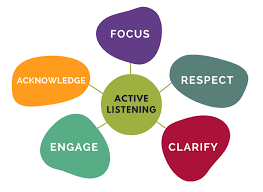In many workplaces, there is a lot of verbal information provided to employees and leaders. This could be in staff meetings, during onboarding, at regular safety meetings or shift meetings as well as in trainings.
It is not uncommon for the presenter or the provider of this information to be an expert or someone experienced in the topic. These people often provide information that is difficult for someone with limited knowledge of the topic, procedure, or activity to fully understand.
To make sure that information is both provided and received effectively, the speaker and the listener both have a role. However, as the listener, it is also up to you to be clear on your understanding of the information provided and to ask questions or seek clarification if it is not clear.
To help to ensure you have the information you need, here are a few simple steps anyone can use to hear and process instructions in the workplace:
- Distraction-free listening – when instructions are provided, focus your mind on the information provided. Do not look at your phone, answer a text, or think about what you need to do when you get out of the meeting. Practice focusing in on the speaker in all conversations and hone this skill.
- Consider jotting down words – taking long, copious, verbatim notes is not effective, and it quickly becomes frustrating and distracting. A person cannot write as fast as someone can talk. A better option is to jot down a keyword or phrase. Some people may create a very simple diagram that jogs their memory, and it all depends on your learning style.
- Use technology – it may be possible to record the discussion with your phone or a device. Always check to make sure this is possible and permissible, and never record without getting permission. Even if you are recording, try to engage in active, focused listening and use the recording only if needed. This is a great way to become comfortable in hearing and remembering instructions while also having a backup.
- Ask questions – if there is confusion or lack of clarity, asking specific questions on areas of difficulty is always an effective strategy. You can even summarize your understanding and verify it is correct, which is a reinforcing activity that supports understanding and recall of the information.
- Detail information – after the meeting, take a minute and expand the notes and perhaps consider a point by point listing of the steps provided in the instruction. It may be possible to simply flesh out the keywords and phrases you wrote down during the discussion, creating a checklist to keep you on track until you master the activity or assimilate the information.
Remember, only you know if the information provided is understood. If you are not clear, be sure you understand before starting the task, as it is easier to ask for guidance before a problem or error occurs rather than after.

